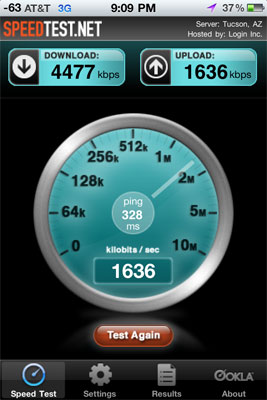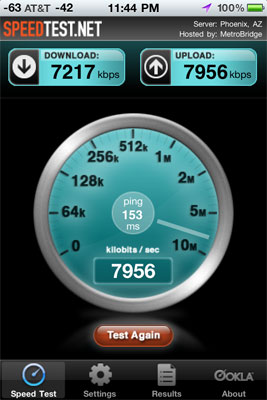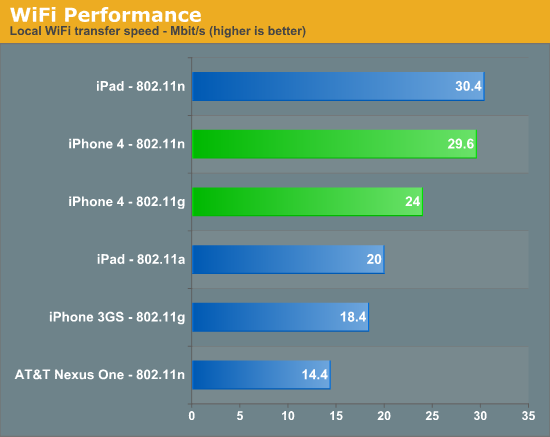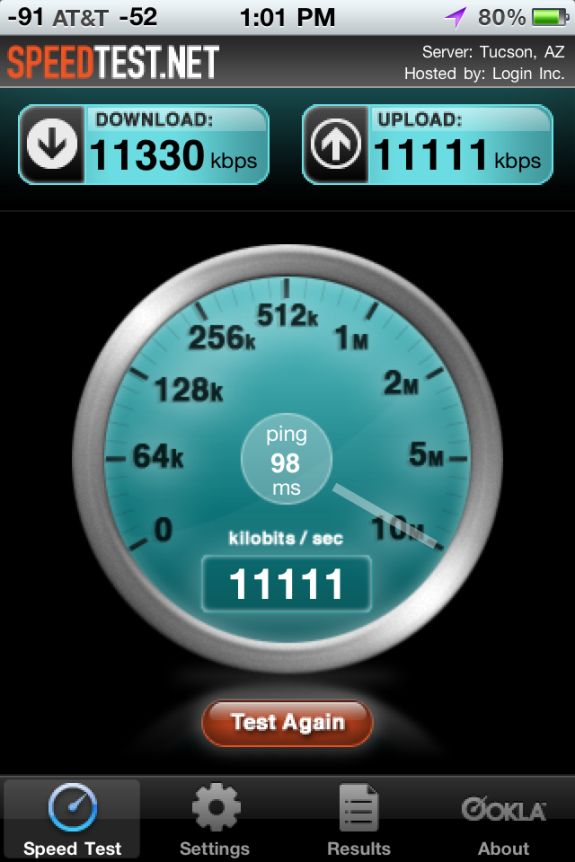Apple's iPhone 4: Thoroughly Reviewed
by Brian Klug & Anand Lal Shimpi on June 30, 2010 4:06 AM EST- Posted in
- Smartphones
- Apple
- iPhone 4
- Gadgets
- Mobile
Network Improvements
The iPhone continues to be an AT&T exclusive in the US. With the iOS 4 upgrades the iPhone 4 supports tethering over Bluetooth or USB. The feature is an extra $20 per month on top of your existing iPhone data plan and it also deducts bandwidth from the 2GB you get with the data plan. It's not a coincidence that AT&T timed the release of its iPhone tethering option with the move away from unlimited data plans. You don't have to give up your existing unlimited data plan if you don't want to, however if you want to enable tethering you have to sign up for the new $25/2GB plan.
I'm not a huge fan of iPhone tethering right now because despite paying for the service and having full signal strength on AT&T, I'm getting horrible transfer rates while trying to upload this article. I had to sign up for airport WiFi to get it live, thanks AT&T. When it does work however, it works well. As you'll see later you can easily get multiple Mbps out of AT&T's network in areas with good coverage. That easily equals the lower end of what you'd see from WiMAX today. As I've mentioned before however, it's really hit or miss with AT&T. The network is either great or totally unusable, while its competitors are generally more consistent but never quite as fast. I'd say that there's a good chance Apple will bring the iPhone to Verizon, it's just a matter of when.
| Cost of Ownership Comparison | |||||
| AT&T iPhone 4 | Sprint EVO 4G | Verizon HTC Droid Incredible | |||
| Cost of Device | $199 w/ 2 year contract | $199 w/ 2 year contract after $100 MIR | $199 w/ 2 year contract | ||
| Plan with 900 Minutes, Unlimited SMS/Data | $104.99/mo, unlimited SMS, 2GB data | $99.99/mo, unlimited SMS, unlimited data, 4G | $109.98/mo, unlimited SMS, unlimited data | ||
| Tethering | + $20/mo | + $29.99/mo | + $25/mo* | ||
| Total Monthly + Tethering | $124.99/mo | $129.98/mo | $134.98/mo | ||
| Total Cost of Ownership over 2 Years | $2718.76 | $2598.76 after $100 MIR | $2838.52 | ||
| Total Cost of Ownership over 2 Years w/ Tethering | $3198.76 | $3318.52 after $100 MIR | $3438.52 | ||
AT&T's plans are actually reasonably priced if you don't go over the data limits. A $15/mo data plan will get you 200MB of transfers per month and $25 will give you 2GB. For users like my parents the 200MB option is great. Even for me personally, 2GB is fine. I tend to peak at 700MB per month, but that's because at the office I'm almost always on my desktop or connected via WiFi. It's unclear how tethering is going to change this for me. Our own Brian Klug on the other hand easily pushes more than 2GB of transfers per month. So AT&T's rate switch is either going to save you a few bucks per month or make you really unhappy.
The iPhone 4 brings HSUPA class 6 for upload speeds of up to 5.76 megabits/s to the platform. This is a 15 fold improvement over the 384 kilobits/s maximum of the iPhone 3G and 3GS, which I routinely see. Not all AT&T markets are updated to HSUPA, and in practice I saw uploads of around 1.5 megabits/s, in line with class 2 or class 3 HSUPA.
Downstream HSDPA speeds remain unchanged from the 3GS, supporting up to 7.2 megabit/s HSDPA. I'm lucky since my market is HSDPA 7.2, as I routinely see speedtests of 5 megabits/s or above very late at night when there isn't very much plant load. I haven't seen any measurable increase in speeds over the 3GS, except in locations with very low signal as noted before.

My fastest iPhone 4 speedtest so far
Even Anand in one of the slowest 3G cities in the US saw significant improvements with the iPhone 4. AT&T's network in general seems to be improving. While the best he'd been able to achieve was around 1Mbps a year ago, these days he can break 2.5Mbps down during the evenings.

iPhone 4 speedtest in Raleigh, NC
WiFi speeds have also improved, as Apple has added 802.11n in the 2.4 GHz band. 5 GHz support remains absent, something which would have likely complicated antenna design even further. Interestingly enough, the BCM4329 WiFi and Bluetooth SoC does contain 802.11a 5 GHz support, the reason it's disabled is again likely due to antenna design constraints. The Broadcom SoC also includes an FM tuner and transmitter, though support for either remains and sadly (given Apple's historical lack of FM radio support) will remain such. Bluetooth 2.1 EDR is there as well.
The iPhone 4 seems to connect at 802.11n rates of 72 megabits/s in best case, far from the maximum without channel bonding of 150 megabits/s. This is still a welcome improvement from the 802.11b/g in the iPhone 3GS, which seemed to never connect above b rates in practice. As an aside, mobile devices using 802.11b rates (modulated using DSSS) are a huge contributing factor to WiFi congestion at conferences - I've even seen DSSS modulated rates (and thus 802.11b devices) explicitly disallowed from connecting to APs at conferences. It's a welcome improvement to see iPhone bringing N support.

A typical WiFi test result
However, even on my 25/4 DOCSIS 3 cable connection, I could only squeeze out a maximum of 8.5 megabits/s down and 8.0 megabits/s up while connected at 72 megabits/s best case. This was using the speedtest.net app to a local test location. I tried with an Airport Extreme (new generation), a WRT600N running DD-WRT, and a WRT54GL-TM running Tomato. All three showed similar results capping out around 8 megabits/s down when I could run tests in excess of 30 megabits down on my desktop. This is probably more of a CPU bottleneck appearing than anything else.
Update:
I thought there was something wrong with my WiFi performance, turns out the iPhone 4 is indeed faster than a palty 8 megabits/s. ;)
There were a number of comments by folks who were able to run speedtest.net and get throughput above 10 or 11 megabits/s. Testing earlier today on a much faster connection, I managed to get something in line with their numbers:
Early today, the folks at DigitalSociety also managed to get much faster WiFi speeds in the neighborhood of 20 megabits/s, way higher than my meager 8 megabits/s. To do so, they loaded an MP3 in safari stored on a local webserver and watched network utilization. I wish I had thought of this, because it's perfect. In the past, the speedtest.net app always used to saturate my connection over WiFi. My only explanation is that the application performs slower over WiFi in iOS 4 than it did in iOS 3, something Anand noted as well. Thanks for all the heads up messages, everyone!
I set up a similar test to DigitalSociety's. I opened an 85 MB PDF stored on my local web server in the browser of each device and watched network utilization using bwm-ng. I tested with an Airport Extreme connected over gigabit to my webserver with no other network utilization. I took the average of 5 runs on the iPad, iPhone 4, iPhone 3GS, and my AT&T Nexus One running Froyo 2.2 (which is 802.11n). The results are much, much more in line with earlier expectations.

The iPhone 4 comes close to but can't quite best the iPad, though the difference is minimal. I did notice that the iPad associates at the same 72 megabits/s connection speed as the iPhone 4. Thankfully, the iPhone 4 easily bests the iPhone 3GS. Finally, although the AT&T Nexus One associates at an 802.11n rate of 65 megabits/s, it's slower than the iPhone 3GS. I have a feeling the device is writing the PDF into flash, whereas the iOS devices are loading it into memory.











270 Comments
View All Comments
Mumrik - Friday, July 2, 2010 - link
Stop that shit. We all know major iPhone (iPod, Windows, Intel CPU etc.) releases matter more for the industry and the majority of people so it is only natural that they put more work into these articles that are going to get more readers. There is one iPhone out there at a time but a gazillion competing Android phones. They can't cover them all like this - that is why they put extra effort into articles that cover Android itself.I say this as someone who has sworn to never own an Apple product.
Henry 3 Dogg - Thursday, July 1, 2010 - link
Re your final comment"Changing the bars visualization may indeed help mask it [the signal drop], and to be fair the phone works fine all the way down to -113 dBm, but it will persist - software updates can change physics as much as they can change hardware design."
From my own tests, I think that you are missing something here.
When you bridge the left corner line and see the signal strength drop, it does so over the course of several seconds. One would tend to assume that this is time averaging in software BUT...
if you make a call in a very weak signal area and then bridge the gap, the call degrades and possibly drops in the same way i.e. over the course of several seconds.
If the whole effect is physics, then the call should degrade instantly - but it doesn't.
Clearly there is a physics effect, but it also appears that the phone software is responding to this physics effect in a manner that makes it more of an issue.
It may/should be possible, by software changes, to make the final signal degradation when the gap is bridged, no more that it is immediately the gap is bridged, and in all honesty that would pretty much close the issue.
Personally I just don't bridge the gap, and then I find, like you did, that I can simply use this phone in places that I've never been able to use a mobile before.
This really is the best phone yet.
John Sawyer - Thursday, July 1, 2010 - link
"It may/should be possible, by software changes, to make the final signal degradation when the gap is bridged, no more that it is immediately the gap is bridged, and in all honesty that would pretty much close the issue."Hopefully this is what Jobs meant when he said, "Stay tuned."
mmike70 - Friday, July 2, 2010 - link
Maybe calls are more forgiving because I haven't had one drop yet. What does happen is when I hold the iphone4 normally in my left hand (I'm right handed, tap with the right hand fingers, hold with the left), the data connection drops immediately. I'm not talking even over the course of five seconds. The currently loading web page will stall the instant I pick the phone up. This is in an area with a very close tower, constant 5 bars on an iphone 4 and 3gs. I can't cradle, grip, pinch, cover, etc the 3gs to make any detectable difference in data performance.chinkgai - Thursday, July 1, 2010 - link
Hey Brian or Anand,Just wanted to point out that on my wireless N/G with the same speedtest.net app tests, my download speed usually always tops out around 10700-11000 kbps, so I'm not sure why you're getting such a low speed on average. It also maxes out my upload speed which is far lower than yours. I'm on a 16/2 line here in Los Angeles.
Great article though!!
bparun - Thursday, July 1, 2010 - link
Obviously a good thorough review. Why is there not a good amount of detail about the newly added Gyroscope in iPhone 4? I have read that its the electronic version of a vibrational one. More on that would be a nice read, as the future of games and apps using this gyroscope for augmented reality would be in abundance. I am sure all the other phone manufacturers are ready to follow, as usual.Mumrik - Friday, July 2, 2010 - link
Such a minor feature in the larger perspective...John Sawyer - Thursday, July 1, 2010 - link
It seems to me, that if the iPhone 4's signal is attenuated when one's hand bridges the gap between the two antennas on the lower left side, but not if one bridges the two antennas by holding the iPhone 4 at its sides, above the gap, that one possible fix for the future, might be to move the gaps so that they're at the topside left and underside left, so one's hand (left or right) doesn't touch the gaps (I doubt many people cover the bottom or top edges of their phones while in use). This would allow the lengths of the two antennas to remain nearly the same, and so it might not compromise the original antenna design's signal strength, unless the original design relies on the upper and lower left corners/ends of the two antennas to be untouched by a user's hand, which would be stupidly unnatural (as nearly everyone notes). If full antenna strength does require these two corners/ends to be uncovered, does this mean the iPhone 4's main radiating signal power, for both antennas, emits from the upper and lower left corners/curved ends of the two antennas, rather than from the entire length of the antennas? If the entire length of both antennas send/receive, moving the gaps to topside left and underside left wouldn't seem to greatly affect the right-side UMTS/GSM antenna's exposure to the world (more critical than the left Bluetooth/wifi/GPS antenna's exposure, since a cell tower is usually further away than a local wireless router, etc.), no matter which hand it's held in (can't say the same for the left-hand antenna, but that may not be important due to closer proximity of wireless routers, etc.); but if the signals for both antennas send/receive mainly from one end of each antenna (currently the curved ends), requiring them to have some uncovered access to the world, then what about moving the gaps closer to the center-top and center-bottom locations? I have a hunch that these potential end-radiating points don't have to be curved, as they currently are at the corners, but maybe I'm wrong. However, this would make both antennas nearly the same length, which might affect signal strength too, if the different frequencies sent/received by the two antennas require their lengths to be as they currently are.
If Apple doesn't want do anything like that (or if the antenna design doesn't allow for it), or even to coat the exposed metal antenna with some kind of clear coat (if that even helps enough), it might be best to move the antennas back inside, wrapped around the inside of the case--I don't think too many users will moan about not being able to touch metal around the sides of the iPhone. Another approach (which would work for either internal or external antennas) might further improve the antenna: two antennas for the phone signal, one at each lower corner (since FCC phone-to-head maximum radio signal level requirements now force manufacturers to put the phone antenna in the bottom of new cellphones), with whichever one that's not covered by the user's hand being used (circuitry in the phone could detect this).
iwod - Thursday, July 1, 2010 - link
1. I dont know why no one mentioned it in their reviews. And only Anand manages to point out my same thoughts, Why no insulation coating on the Stainless steel? It add less then 1mm of thickness and is cheap and easy enough to do so.The only reason would be Apple Engineer were using 3GS casing while they were testing..
2. No one mentioned the new Skyworks Baseband chip. I have never head of them, and dont know how good they are. Wiki shows they have been in the business for nearly a decade now, so that should be good. The Less Drop calls on iPhone 4 were more to do with this Chips instead of AT&T network upgrade. The previous Infineon Chipset were simply poor. It was Infineon first chip into communication and mobile network. And it didn't work well although the problem were easily pointed to AT&T network. It wasn't only AT&T were having drop calls, Every iPhone 3G user in the world were having drop calls with different Network. And the Drop Calls rate for iPhone 3G/3GS on AT&T were much higher then any other phones on AT&T network. That simply points to a problem the lies within iPhone.
3. The iPhone A4 is a package on package SOC. The Memory was Dual Channel Low Power DDR. Why didn't they use Low Power DDR3? It is lower power and faster then ancients DDR.
4. Why didn't Apple upgrade their GPU? The iPhone 4 is 4x as much resolution. Playing Games on it requires much more computational power.
5. 110ppi may not be enough for desktop. But how many ppi would a Retina Display for Desktop and Notebook need? I just measure we are typlically at least 24 inch away from the monitor, double the distance as you would hold on a iPhone. If a iPhone 4 requires 330 ppi, then Double the distance would half the ppi, which means 165ppi, That means 2560 x 1200 Resolution for 18" Display. For a Large Desktop Display 27", you will need 4K ( 4096×1716 ) resolution, which is actually perfect for Digital Film making and Broadcasting. I think it is time we distinguish a Computer Display to Normal TV. They can keep with their 1080P for as long as they want. We want Retina Display on our Mac.
( Notes: However even the lastest DisplayPort 1.2 does not offer enough bandwidth for 4K resolution )
6. Software Side - Some Reports indicate iOS 4.0 uses more memory then older iOS 3.0 which more useless process standby ( Such us Internet tethering and Bluetooth.exe even when both features are OFF ). While they may only consumer 2 - 3MB of memory. It is still a lot on a mobile devices. I hope anand can verify if they have time.
7. Saferi on iOS 4.0 seems to be using a older version of WebKit as well. I am sure SunSpider will run faster and on par with Andriod once Apple update iOS.
brownreese - Thursday, July 1, 2010 - link
I am blown away by the thoughtfulness of this review. Too many sites read like regurgitated press releases. I have just become a lifelong reader. Thanks.